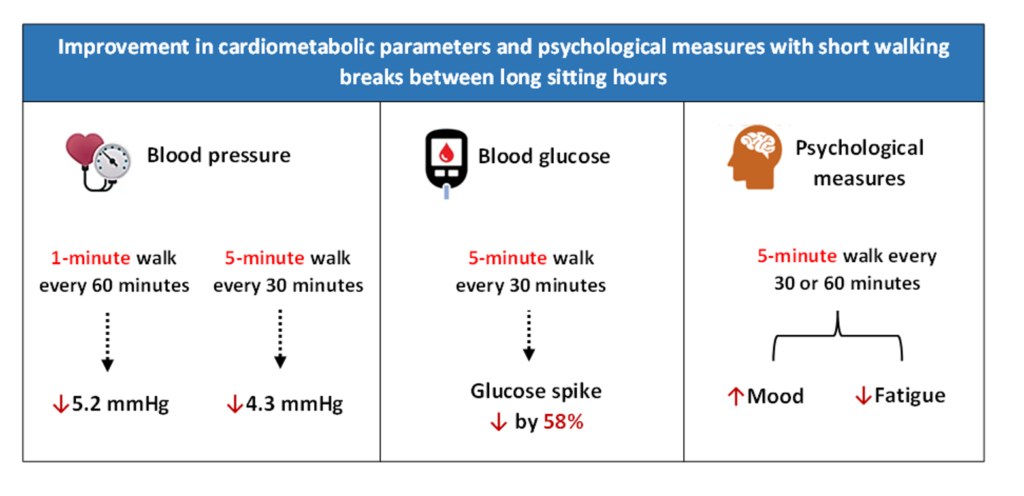
A recent study published in the journal, Medicine & Science in Sports and Exercise, reported that 5-minute walking breaks between prolonged sitting hours could reduce cardiometabolic risk. Walking breaks taken every 30 or 60 minutes of sitting periods reduced blood pressure (BP) as well as blood glucose. Decrease in blood glucose was more pronounced with a 5-minute walking break taken every 30 minutes. In addition, 5-minute walking breaks every 30 or 60 minutes significantly improved vigour, and reduced fatigue and stress.
A randomized, cross-over trial included middle-aged and older-aged adults (n = 11; mean age = 57 years) to assess the effect of short breaks (1-min or 5-min walking every 30 or 60 minutes) between prolonged sitting hours on cardiometabolic parameters (blood glucose and BP) and psychological measures (fatigue, stress, and cognition).
All participants received a standard breakfast, followed by a standard lunch after 4 hours. They were exposed to various 8-hour conditions on five separate days, viz., sedentary condition with no breaks (control) and 4 different sedentary break frequency/duration combinations: walk every 30 min for 1 min, every 30 min for 5 min, every 60 min for 1 min, and every 60 min for 5 min. Along with blood glucose and BP, psychological measures such as fatigue, mood, and cognition were also assessed. The results are summarized below (see the graphic):
- Majority of the participants (≥80%) reported willingness to take 1-minute or 5-minutes breaks every half hour or 1 hour, over the long term rather than sitting for longer duration without breaks.
- Significant reduction in systolic BP was noted with all the four sedentary break frequency/duration combinations (p <0.05); however, 5-minute walk every 30 minutes resulted in a significant reduction in glucose incremental area under the curve (p = 0.017; see the graphic).
- 5-minute breaks after sitting for 30 or 60 minutes were also associated with significant improvements in fatigue and mood of the participants compared to the 1-minute break.

Clinical implication: This study highlighted the importance of regular bodily movements in the form of short walks after every 30 or 60 minutes of sitting. Optimal break of 5 minutes every 30 minutes is helpful in improving the cardiometabolic and mental health in individuals with sedentary work-life, involving prolonged sitting behind the desks. Notably, it was observed that short walks to break up sitting can improve the mood, increase energy, and enhance the overall work productivity.
(Reference: Duran A, Friel C, Serafini M, Ensari I, Cheung Y, Diaz K. Breaking up prolonged sitting to improve cardiometabolic risk: Dose-response analysis of a randomized cross-over trial. Med Sci Sports Exerc. 2023. Doi: 10.1249/MSS.0000000000003109)
